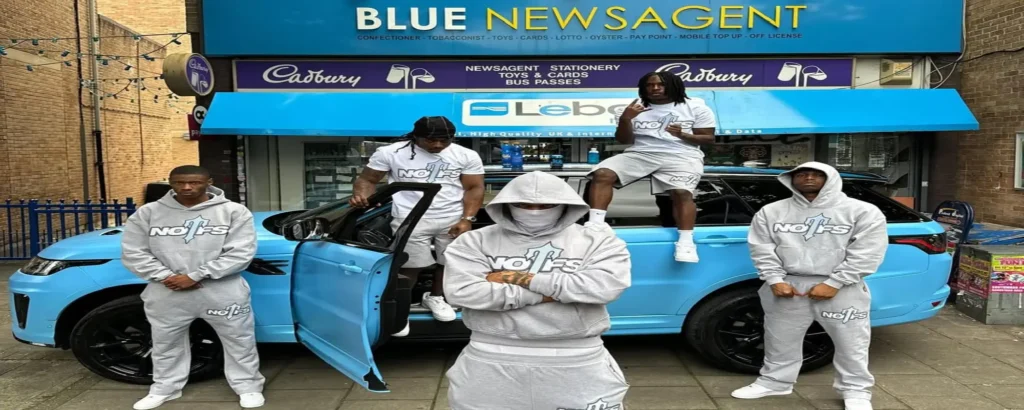If you’ve strolled the roads of Paris lately—or Marseille, Lyon, or Lille—you might’ve spotted something mixing underneath the surface of France’s mold scene. A image stamped in crude vitality and resistance. A striking symbol that dares to whisper, “It’s a secret….” That’s Trapstar. A development, not a fair name for a piece of apparel. One that’s invaded French urban culture and made a domestic in the heart of its youth.
From London to Le Marais: A Brand That Talks the Streets
Trapstar was born in the shadows of West London—no runways, no shiny campaigns—just coarseness, energy, and community. What begun as companions printing tees for their circle rapidly got to be the UK’s underground staple. But France, with its starvation for independence and edge, opened its arms wide to this wave.
Fans of French streetwear, who have always been drawn to a blend of style and message, identified with Trapstar’s look. Its overwhelming illustrations, armored puffers, and smooth tracksuits found a put nearby the avant-garde and the nostalgic. But Trapstar isn’t fair style—it’s attitude.
Trapstar and the French Youth Rebellion

In neighborhoods over France, from the high-rises of Seine-Saint-Denis to the aesthetic enclaves of Bordeaux, Trapstar is more than a slant. It’s a way of life. It captures that fretful energy—the crave to stand out, to talk truth without words, to flip the script.
The brand reverberates with French youth since it doesn’t imagine. There’s no made cool here. Whether it’s the signature “Shooter” coats or the notorious trademark tees, the pieces feel lived-in, like they’ve as of now strolled the back streets and battled the fights. For numerous youthful Parisians, putting on Trapstar isn’t approximately fashion—it’s almost armor.
The Request of Authenticity
What sets Trapstar separated in France’s swarmed mold showcase is its refusal to compromise. French shoppers, known for their appreciation of make and creativity, are drawn to the brand’s crude trustworthiness. Whereas other names chase regular prevailing fashions, Trapstar builds bequest through consistency—anchored in dark, ruddy, and rebellion.
You’ll see it on craftsmen, competitors, and activists—people who’ve built their character exterior the conventional lines. From hip-hop specialists performing in underground clubs in Marseille to skateboarders flipping traps beneath the Pont de Bir-Hakeim, Trapstar is all over. It’s gotten to be an insignia of those who live exterior the box and aren’t anxious to appear it.
A Social Bridge Between UK and France
In a way, Trapstar has gotten to be a bridge between British and French road societies. The two scenes share roots in resistance—against prohibition, against desire, against hush. And Trapstar, with its proud tone and community-first ethos, encapsulates that resistance.
When French fans wear Trapstar, they’re interfacing to something worldwide, however heightening individual. It’s a identification of belonging—but too resistance. “I know where I come from, and I won’t be calm around it,” it affirms.
Limited Drops, Most extreme Impact
Trapstar’s constrained discharges have made a starvation in France’s fashion-forward circles. It’s not exceptional to see early morning lines exterior streetwear boutiques in Paris amid a modern drop. The shortage isn’t fair marketing—it makes a sense of community and criticalness, something profoundly esteemed in French design culture.
Every collection drop feels like a moment—something earned, not bought. That feeling is effective. And in France, where design frequently inclines toward the cleaned and curated, Trapstar brings back the excite of crudeness and risk.
Collaborations That Hit Home
Part of Trapstar’s rise in France comes from its savvy collaborations. Whether it’s joining forces with worldwide names or music symbols, the brand ministers its inventive joins carefully. In doing so, they maintain a strategic distance from the trap of offering out, instep multiplying down on their credibility.
These collaborations regularly mix consistently with French tastes. When Trapstar taps into hip-hop culture or sportswear legends, it talks to a era in France that’s continuously adjusting the neighborhood with the global.
Streetwear’s Soul Still Beats Loud
What makes Trapstar reverberate so profoundly in France isn’t fair the fit or the flair—it’s the soul. There’s a beat in each fasten, a sense of pride in each symbol. In a nation that regularly romanticizes couture, Trapstar reminds the youth that genuine design lives on the road, in the voice of the unheard, in the swagger of the overlooked.
Wearing Trapstar in France feels like a articulation. You’re saying you don’t require approval. That your story is worth telling, indeed if no one given you a mic.
Trapstar in the Advanced and Physical Worlds
Social media has supercharged Trapstar’s nearness over France. On TikTok, Instagram, and Snapchat, French makers grandstand their fits, mixing Trapstar with Nike Shox or blending the brand with vintage Dior. It’s a visual culture clash that by one means or another feels cohesive.
But whereas computerized impact spreads quick, Trapstar keeps up its roots on the ground. It’s this balance—online reach and offline soul—that’s fueled its remaining power.
More Than a Brand—A Development in France
Trapstar didn’t inquire for authorization. It arrived in France as a whisper, at that point a thunder. Presently, it’s sewed into the country’s urban personality. It lives in the playlists of bore specialists, in the Instagram reels of design understudies, and in the hearts of kids who developed up knowing that fashion isn’t fair what you wear—it’s how you carry your struggle.
The excellence of Trapstar in France is how it adjusts without changing. It molds to the French lanes whereas remaining genuine to its roots. In a world where brands regularly lose their soul chasing development, Trapstar holds the line.
And that’s precisely why it’s not going anywhere.
Final Word
Trapstar clothing has developed into a social drive in France—not through advertisements or supports, but by talking the dialect of the boulevards. It’s genuine. It’s individual. And flexibility has finally arrived in every area where young people still desire for it.

